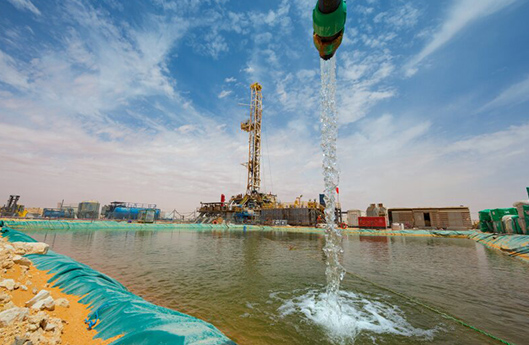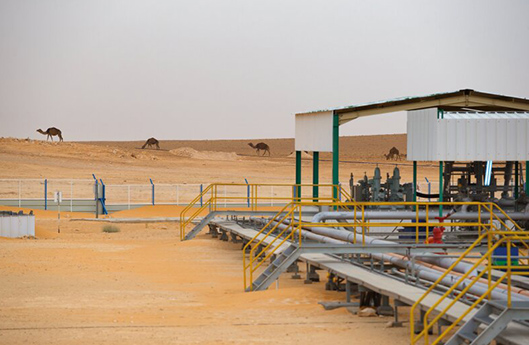Water management

OMV Upstream and Downstream operations both affect water resources. OMV uses significant amounts of water for its operations in Upstream as well as in Downstream activities. Freshwater is used, for example, for drilling, steam generation, and cooling, among other processes. Smaller amounts of water are also used for non-industrial purposes. Some water used in operations is recycled back for reinjection to pressurize hydrocarbon reservoirs in order to optimize the extraction rate.
Desalinated water is used in some offshore operations. Refineries and various other operating facilities also use brackish and/or recycled water for various operational purposes. Some of OMV’s operating facilities are located in water-stressed areas.1Water stressed areas are areas where the demand for water exceeds the available amount during a certain period or when poor quality restricts its use. In such areas, water stress causes deterioration of freshwater resources in terms of quantity (aquifer over-exploitation, dry rivers, etc.) and quality (eutrophication, organic matter pollution, saline intrusion, etc.). Source: European Environmental Agency www.eea.europa.eu/themes/water/glossary
The key goals of our water management activities are to reduce water consumption, to utilize water resources efficiently, and to treat wastewater appropriately.
Our impact on water resources is material to stakeholders as follows:
- Government authorities (regulatory and river basin management authorities): compliance with water use rules and environmental parameters relating to wastewater generated
- Local communities: sharing of local water resources and the quality of discharged wastewater
- NGOs/NPOs: environmental preservation and water resource conservation
- Local water utilities: supply of freshwater (for OMV operations)
Water Ambition Statement
The Company’s commitment to water management is based on OMV’s Water Ambition Statement. We respect water as a precious limited resource and focus on its sustainable use.
- We are committed to meeting all applicable legislative requirements or our OMV regulations – whichever is more stringent.
- Water management is a key component of our social license to operate. We cooperate with local communities and prove to be responsible partners.
- We are committed to transparency when it comes to our impact on water resources.
- Every OMV employee is responsible for minimizing the impact of our activities on water resources.
OMV’s Group-wide Water Strategy was developed in 2014 and is based on five strategic pillars:
- Transparency
- Risks and opportunities
- Water efficiency and treatment
- Training and awareness
- Stakeholder engagement
In line with the great importance of the material topic of water management, we will continue to plan to establish targets to improve water consumption efficiency. For the Sustainability Strategy 2025, however, we have prioritized safety-related targets in the focus area of HSSE. Environment-related targets were incorporated as part of the Carbon Efficiency focus area. OMV’s Water Strategy was reviewed in 2019 and will be revised in 2020.
High-level water stress assessments are conducted on an annual basis. OMV uses international tools and indexes, such as Verisk Maplecroft’s “Water Stress Index” complemented by the World Resources Institute’s (WRI) Aqueduct “Baseline Water Stress” index, as well as own assessments as required, to identify operations in areas affected by water scarcity and water stress. Operating facilities located in places that are affected or are likely to be affected by water scarcity issues and operations utilizing significant water resources (i.e., Tunisia) are prioritized when developing and implementing water management plans. These plans aim to allow sustainable long-term production with minimal effects on the environment. 75% of priority sites have completed water management plans, with the development of plans in progress at the remaining sites.
A bottom-up approach in the assessment of water-related risks is taken in accordance with the OMV’s Group-wide Environmental Risk Assessment (ERA) guideline to ensure consistent qualitative assessments of operational risks and impacts related to the environment, including water. Significant risks are integrated into OMV’s Enterprise-Wide Risk Management (EWRM) system.
When entering a new country or considering new operational activities, OMV primarily uses the World Resources Institute’s (WRI) Aqueduct and Verisk Maplecroft indexes to identify future potential water-related constraints, such as baseline water stress, groundwater stress, and seasonal variability.
Freshwater withdrawn
In megaliters
Water-management-related risks are closely linked with the material topic of spill prevention. Offshore operations may lead to oil spills with significant impact on marine water resources and ecosystems. The response strategy aims to minimize the probability of such risks and maximize readiness so that we can provide timely remediation measures in the unlikely event of an oil spill. OMV allocates significant resources to prevention and mitigation measures. Any new or existing offshore drilling activity is accompanied by a third-party analysis evaluating the magnitude of a major event and its possible consequences. As part of the biannual Group-wide EWRM process, water-related risks and mitigation measures are assessed in a larger strategic context, while a systematic approach is taken in day-to-day operations to monitoring and managing high-impact/low-probability risks, such as blowouts during offshore drilling.
Rehabilitation of industrial water distribution system at Suplac
In 2019, we continued to rehabilitate the industrial water distribution system in four parks (16, 24, 31, and 49) at our Upstream Suplac site Romania. Around 853 meters of new pipe were installed at a cost of around EUR 316,000. Project benefits include avoiding water losses from old water hydrant networks and pipelines, as well as improved safety in operations.
OMV adheres to the requirements laid down in local legislation when setting standards for effluent discharge quality. The OMV Group Environmental Management Standard requires all OMV businesses and activities to minimize the impact of effluents on the environment and local communities and outlines specific requirements for wastewater discharge onshore and offshore. The direct discharge of wastewater on land, in wetlands, or in other bodies of water without prior treatment is not permitted. The standard furthermore stipulates that no discharge may alter or diminish the value of the receiving environment. All discharge must be systematically monitored and any environmental impacts must be managed appropriately.
In areas where OMV operations require large amounts of water, it is particularly important to include local stakeholders in water management activities in order to secure a “social license to operate.” Among the most important stakeholders OMV includes in defining socially equitable, environmentally sustainable, and economically beneficial water management practices are local communities, neighboring industrial facilities, NGOs, regulators, and river basin management authorities.
OMV water management activities pursue socially equitable water use. In our Human Rights Matrix, we commit to ensuring an adequate standard of living, including access to water and food for our employees. This applies not only to our own operations but also to those of our suppliers that sign and commit to following the OMV Code of Conduct. As indicated in the Supply Chain section, OMV regularly carries out supplier audits to ensure compliance with our human rights requirements.

To ensure that the interests of local communities are known and taken into account during the project life cycle, OMV conducts social baseline studies and community needs assessments as part of Social Impact Assessments (SIAs). (For more information on SIAs, see Community Relations and Development.)
Following these assessments, OMV launches community projects aimed at increasing access to clean water for local communities. This partnership with local communities allows them to benefit from OMV’s presence in the region and provide consent for the use of natural water resources in their area. Examples of OMV support for local communities in Libya to water-use-related projects can be found under Community Relations and Development.
Local regulatory and river basin authorities are involved whenever needed to ensure that OMV is in compliance with local environmental regulations and has obtained all of the required permits for freshwater usage and wastewater discharge.
Water efficiency activities
In 2019, modernization of the Săcuieni water station in Upstream’s Muntenia asset was completed. This facility ensures fully automated control of the water flow so that water delivery can be finely tuned to water requirements and so that water withdrawal does not exceed water demand. The water station is located in the Ialomița river basin, which experiences water scarcity and water stress risk in dry years according to the Romanian National Institute of Hydrology and Water Management. In addition to minimizing the environmental impact, this upgrade also enables increased reliability of the water supply for production.
In 2019, we continued to evaluate the water risks of the largest water users at OMV Petrom. Water risks were assessed for the Brazi power plant in Downstream and for the Crisana asset in Upstream by using the WWF Water Risk Filter. This takes into account physical criteria, such as water scarcity (determined by considering access to water resources, competing needs, and supply patterns in the region) and water stress (defined by the physical availability of the water resources), as well as compliance and reputational aspects.
Given that some regions where OMV Petrom operates have already experienced water stress in dry years, and the fact that we expect a further decline in water availability, we determined the need to continue implementing measures for efficient water use.